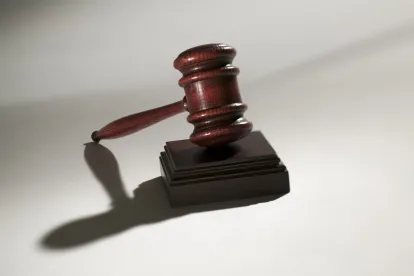The Supreme Court has narrowed the scope of the laches defense in patent infringement actions, aligning its interpretation of laches under the Patent Act with that under the Copyright Act.
On March 21, the US Supreme Court issued its long-awaited decision in SCA Hygiene Products, Inc. v. First Quality Baby Products, LLC and held that the equitable defense of laches cannot bar pre-suit damages for timely asserted patent infringement claims.
In a 7-1 decision authored by Justice Samuel Alito, the Court reaffirmed that “[p]atent law is governed by the same common-law principles, methods of statutory interpretation, and procedural rules of other areas of civil litigation” such that—contrary to what the en banc US Court of Appeals for the Federal Circuit had opined—the Supreme Court’s jurisprudence precluding the application of laches to damages claims applies to claims for patent infringement.[i]
Background
The laches issue in SCA mirrors an issue the Supreme Court considered three terms ago in Petrella v. Metro-Goldwyn Mayer, 134 S. Ct. 1962 (2014). In Petrella, a divided Supreme Court—relying on interpretation of legislative history of the Copyright Act and common-law principles—held that laches cannot be invoked as a bar to legal relief for a claim asserted within the Copyright Act’s three-year statute of limitations.[ii] While discussing laches in the copyright infringement setting, the Court acknowledged that the Federal Circuit applied a contrary rule in the patent infringement setting—permitting laches to effectively shorten the Patent Act’s six-year limitations period—but noted that the applicability of laches in a patent infringement action was neither before the Court nor something that the Court has “had the occasion to review.”[iii]
The Court’s occasion to review laches in the patent setting arose out of a dispute between SCA Hygiene Products Aktiebolag and SCA Personal Care, Inc. (collectively, “SCA”)—manufacturers and sellers of adult incontinence products—and First Quality Baby Products, LLC, First Quality Hygienic, Inc., and First Quality Retail Services, LLC (collectively, “First Quality”)—manufacturers of private label disposable incontinence products.
In 2003, SCA sent a letter to First Quality claiming that First Quality infringed US Patent No. 6,375,646, which claimed a disposable, absorbent pant-type diaper with certain features.[iv] In July 2004, after subsequent exchange of correspondence, SCA filed a request for reexamination of its own ’646 patent.[v] SCA did not inform First Quality about the petition for reexamination.[vi] Three years later, in March 2007, the US Patent and Trademark Office upheld the validity of all claims of the ’646 patent.[vii]
In August 2010, over three years after the reexamination concluded and over six years after SCA’s initial letter to First Quality regarding the ’646 patent, SCA filed suit against First Quality for infringement of the ’646 patent and declaratory judgment.[viii] First Quality moved for summary judgment on the basis of equitable estoppel and laches. The US District Court for the Western District of Kentucky granted summary judgment on both grounds. The district court held that laches barred SCA from recovering damages that accrued prior to filing suit and that equitable estoppel barred SCA’s suit in full.[ix]
SCA appealed. Prior to the Federal Circuit’s panel ruling, the Supreme Court issued its opinion in Petrella.[x] Despite the ruling in Petrella, the Federal Circuit panel affirmed the district court’s grant of summary judgment with respect to laches, relying on the Federal Circuit’s 1992 ruling in A.C. Aukerman Co. v. R.L. Chaides Constr. Co. where the en banc Federal Circuit held that laches may preclude recovery of pre-suit damages for a timely asserted patent infringement claim.[xi]
The Federal Circuit then re-heard the appeal en banc in order to address the question of whether Aukerman remained good law in light of Petrella. In a 6-5 decision, the Federal Circuit—relying on §§ 282 and 286 of the Patent Act and prior case law regarding the applicability of laches—reaffirmed Aukerman’s holding regarding laches as a bar to damages.[xii]
The Supreme Court granted certiorari to consider whether and to what extent the defense of laches may bar a claim for patent infringement asserted within the Patent Act’s six-year limitations period.
The Court’s Decision
The Supreme Court vacated the en banc Federal Circuit ruling insofar as it held that laches could be interposed as a defense against damages where the infringement occurred within the six-year period prescribed by § 286 of the Patent Act. [xiii] The Court held that the en banc Federal Circuit ruling was contrary to Petrella and unsupported by the Patent Act.
Despite the differences between the nomenclature of the Copyright Act and the Patent Act, the Court held that “Petrella’s reasoning easily fits” § 286 of the Patent Act—which mandates that “no recovery shall be had for any infringement committed more than six years prior to the filing of” a lawsuit—because § 286 “represents a judgment by Congress that a patentee may recover damages for any infringement committed within six years of the filing of the claim.”[xiv]
After determining Petrella was dispositive of the question before it, the Court discussed the flaws in the reasoning of the Federal Circuit and First Quality:
-
The Court held that even assuming § 282 of the Patent Act codified a laches defense to patent infringement, this is insufficient to demonstrate that the laches defense affirmatively displaces the otherwise applicable six-year limitations period. The Court emphasized that “it would be exceedingly unusual, if not unprecedented, if Congress chose to include in the Patent Act both a statute of limitations for damages and a laches provision applicable to a damages claim” as there is not a single federal statute that provides such dual protection against untimely claims.[xv]
-
The Court rejected as unsupported the Federal Circuit’s conclusion that when Congress adopted § 282 of the Patent Act, Congress opted to codify a “well-established practice of applying laches to” damages claims.[xvi] The Court emphasized that “[t]he most prominent feature of the relevant legal landscape at the time of the enactment of the Patent Act” was the well-established rule that laches cannot bar a claim for damages incurred within a statutory limitations period.[xvii] In light of this landscape, the Court opined that “only a broad and unambiguous consensus of lower court decisions” could establish that § 282 codified a “very different patent-law-specific rule.”[xviii] There was no such consensus because even First Quality’s own cited pre-1952 decisions did not establish a consensus governing damages claims asserted in courts of law.[xix]
-
The Court held that there was no evidence that Congress has ratified any decisions of Courts of Appeals that were issued after enactment of the Patent Act in 1952 and which had held that laches may be invoked as a defense against a claim for damages.[xx]
-
Finally, the Court rejected policy arguments asserted by First Quality and various amici that had argued that reversal of the Federal Circuit’s holding that laches could apply to bar timely asserted claims would permit “unscrupulous patentees” to induce “potential targets of infringement suits to invest in the production of arguably infringing products” while the patentee lies in wait to bring an infringement action to recover profits years later.[xxi] The Court reaffirmed separation of powers and the prohibition on the Court overruling the judgment of the US Congress based on the Court’s own policy views, and opined that the asserted policy concerns can be addressed through other recognized equitable defenses such as equitable estoppel.[xxii]
Looking Ahead
The Court’s decision has removed the uncertainty regarding whether laches can bar pre-suit damages for timely asserted patent infringement claims. In light of this clarity, patentees and accused infringers alike should reexamine their strategies for litigation, pre-suit settlement, and licensing negotiations.
[i] See No. 15-927, slip. op. at 10 (citation omitted).
[ii] See 134 S. Ct. at 1978.
[iii] Id. at 1974 n.15 (discussing A.C. Aukerman Co. v. R.L. Chaides Constr. Co., 960 F.2d 1020 (Fed. Cir. 1992) (en banc)).
[iv] See No. 15-927, slip op. at 1-2.
[v] See id. at 2.
[vi] See id.
[vii] See id.
[viii] See id.
[ix] See id.
[x] See id.
[xi] See id. (citing A.C. Aukerman Co. v. R.L. Chaides Constr. Co., 960 F.2d 1020 (Fed. Cir. 1992)).
[xii] See No. 15-927, slip op. at 2-3.
[xiii] See id. at 16.
[xiv] Id. at 5-6.
[xv] Id. at 9.
[xvi] Id.
[xvii] Id. at 9-10.
[xviii] Id. at 10.
[xix] Id. at 11-15.
[xx] See id. at 15-16.
[xxi] Id. at 16.
[xxii] See id.





 />i
/>i

